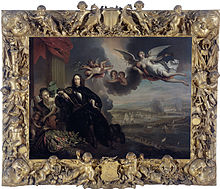
Back Apotheose ALS تأليه Arabic Apofeoz Azerbaijani Апафеоз Byelorussian Апотеоз Bulgarian Апофеоз BXR Apoteosi Catalan Apoteóza Czech Apoteose Danish Apotheose German


Apotheosis (from Ancient Greek ἀποθέωσις (apothéōsis), from ἀποθεόω/ἀποθεῶ (apotheóō/apotheô) 'to deify'), also called divinization or deification (from Latin deificatio 'making divine'), is the glorification of a subject to divine levels and, commonly, the treatment of a human being, any other living thing, or an abstract idea in the likeness of a deity.
The original sense of apotheosis relates to religion and is the subject of many works of art. Figuratively "apotheosis" may be used in almost any context for "the deification, glorification, or exaltation of a principle, practice, etc.", so normally attached to an abstraction of some sort.[1]
In religion, apotheosis was a feature of many religions in the ancient world, and some that are active today. It requires a belief that there is a possibility of newly-created gods, so a polytheistic belief system. The major modern religions of Christianity, Islam, and Judaism do not allow for this, though many recognise minor sacred categories such as saints (created by a process called canonization). In Hinduism there is some scope for new deities. A human may be deified by becoming regarded as an avatar of an established deity, usually a major one, or by being regarded as a new, independent, deity (usually a minor one), or some mixture of the two.
In art, an apotheosis scene typically shows the subject in the heavens or rising towards them, often accompanied by a number of angels, putti, personifications of virtues, or similar figures. Especially from Baroque art onwards, apotheosis scenes may depict rulers, generals or artists purely as an honorific metaphor; in many cases the "religious" context is classical Greco-Roman pagan religion,[2] as in The Apotheosis of Voltaire, featuring Apollo. The Apotheosis of Washington (1865), high up in the dome of the United States Capitol Building, is another example. Personifications of places or abstractions are also showed receiving an apotheosis. The typical composition was suitable for placement on ceilings or inside domes.
© MMXXIII Rich X Search. We shall prevail. All rights reserved. Rich X Search